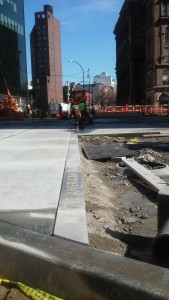Astor Place Reconstruction Recalls Historic Streets, Mosaics & The Alamo

If you are one of the over 100,000 people a day that make your way through Astor Place or Cooper Square, you cannot help but notice the amazing amount of progress that is evident by the workers on the long awaited reconstruction. The cement is still drying in some parts, but more of the major components of the Astor Place / Cooper Square area are coming into view. The Alamo, features of the historic streets and trails, as well as the impressive street furniture mosaics, will all be prominent features of the redesign.

The product of many years of work and labor and at an overall cost of $16 million, one of the most unique intersections of New York is getting ready for it’s unveiling this summer. The Alamo (Cube Sculpture) is returning this summer, plantings will arrive in June, and the north plaza is expected to be finished in August. A celebratory public event is also in the planning, and the multi-phased approach will allow New Yorkers and visitors to incrementally experience the newly created space.
The re-visioning for the vibrant intersection goes all the way back to a 1998 study by Project for Public Spaces, whose offices are nearby. NYC Department of Transportation (NYCDOT) led the current design effort that begin nearly 10 years ago, spurred in part by the Village Alliance and other stakeholders’ desire for more and better neighborhood public space.
The current construction process started in 2013, and has been complicated by the combination of private and public land ownership. Additionally, the delicate dynamics of staging such a project above a subway station in use added to the time and complications.
As has been reported elsewhere, the Alamo sculpture by Bernard (Tony) Rosenthal, is coming back for sure, and a one-night-only appearance on Halloween last year piqued further the eager anticipation. While being worked on in New Jersey, the turning base of “The Cube” is being cleaned for the first time since it’s installation in 1967.

In 2011 GVSHP asked that any changes to Astor Place and Stuyvesant Street respect and preserve the significant history of these most historic of streets as they are pedestrianized and reworked as part of this project — Stuyvesant Street, Astor Place, and the Bowery are among the oldest streets in New York.

GVSHP recommended that their former routes should be made plainly clear in the design, and their paths should continue to be distinct, with a permanent commitment that the memorialization of these highly‐significant historic roadbeds be maintained in perpetuity.
The historic street patterns are being recognized with granite inlays in curb markings that reflect the previous path of the streets. There are three such treatments in total in the final design now under way, with two already visible.
Another important issue GVSHP (and many others) consistently raised was the need to preserve and restore the mosaics by world renowned local artist Jim Power. Since the 1980’s, Mr. Power has decorated dozens of lampposts with brightly colored, often recycled tile and glass, serving as an ever evolving local history of the neighborhood. Mr. Power has also been commissioned to enhance the entries and doorways of local buildings.
Commitments have been made to preserve and reinstall the mosaics, and work is underway to do this. The light poles upon which the mosaics were placed have been

saved, cared for and prepped to be re-incorporated as streetscape elements into the Astor Place redesign. The light posts will no longer be functional, but the mosaics will serve as iconic sculptures for the neighborhood. The restored poles with mosaic tiles will provide an echo to the nearby grand columns of Colonnade Row/La Grange Terrace (1832) on Lafayette Street.


The current plan is for Mr. Power to personally work on the restoration of the unique poles before they are installed. As details are worked out as to studio space and available resources, there may be emerging opportunities for interested people and parties to be supportive of this important initiative moving forward.
Adding an important environmental touch are 56 new trees and native plantings that are landscaped to connect the north and southern ends of what is in essence a newly configured public space. Planted in bio-swales that capture rainwater, the landscape design is more self sustaining as far as watering and care, and will harken to the original plants of the area. Grace Church High School will be tending to gardens on the southern portion of the area.
The Village Alliance and Project for Public Space created an activation plan for programming and use of the space. The ultimate goal of their approach is to develop an inspiring and agreed upon vision and a program, which builds consensus and capacity to transform Astor Place into one of the great public spaces in New York City. Share your ideas and suggestions here.
Village Alliance Executive Director William Kelley worked on the visioning of this overall long-term effort as a graduate student in the Masters Degree program in Urban Planning at NYU, and is keen on its success.
To see the latest weekly progress update to date, and how to get on the NYC Department of Design and Construction notification list, visit here.
![]()

2 responses to “Astor Place Reconstruction Recalls Historic Streets, Mosaics & The Alamo”